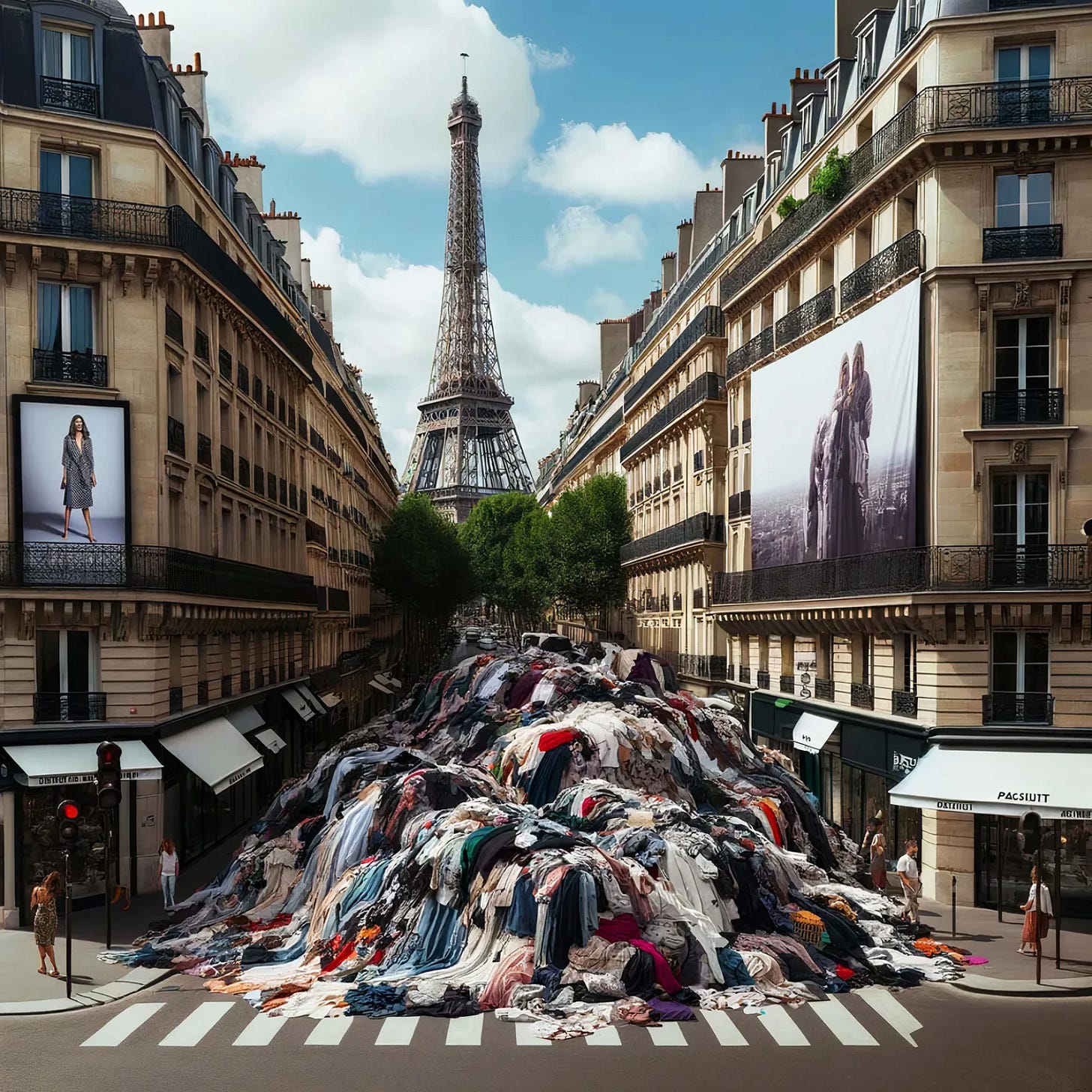Diet culture, beauty culture, fast fashion culture
Optimise everything, just not workers rights!
[all opinions expressed are my own]
AI-generated image via Vestiare Collective, who recently banned users from selling ‘fast fashion’ on its (luxury-focused) resale platform.
‘Tis the season for new years’ resolutions! Despite their high failure rate and generally cringy quality, I’m actually a big fan of using January for goal-setting and working towards changing habits or trying new things. I think it helps my brain make sense of the linear progression of time throughout my life. Or maybe I’m just a victim of internalised capitalism and the endless drive for productivity, individual responsibility and the ladder of self-improvement. Who can tell.
But what I wanted to talk about here is the connection between the non-stop growth of fast fashion (despite headlines of ‘resale taking over’ and ‘green is the new black’, fast fashion’s market value continues to explode), and the deeply entrenched health and beauty related norms and expectations in our society at large. In short, the factors that drive our consumption of fashion (the lack of public data about impacts, filling the void left by isolation from community, manipulative marketing that preys on low self-esteem, the culture of comparison from social media’s highlights reel, false presentations of cost and value, etc.), are identical to some the factors that drive us to buy anti-ageing skincare products, go on fad diets, shave our body hair, get cosmetic surgery and botox, overexercise, undersleep - the list goes on.
Part of this line of thinking comes from personal experience. I know that despite my better judgement, I often find myself zoning out and buying ‘stuff’ to improve my appearance in some way, and that beneath this is a desperation to not fall behind the expectations of me as a woman in the world. I know that my own battle with an eating disorder for well over a decade has at times produced something like a fast fashion and beauty product addiction, numbing emotions and physical needs with the acquisition of yet more ‘stuff’. I know that the real, authentic desire I have to be a better version of myself is often co-opted by the lie that this optimised self can be achieved through the consumption of products and services that put profit in the pockets of, let’s face it, mostly men who benefit from a bottomless pit of potential for women’s desire to be ‘better’.
So, this January, as many of us strive, in big or small ways, for self-improvement, can we direct some of that energy towards improving the system that keeps us questioning our worth? In some ways, I think the fashion system is the perfect microcosm of these issues, so maybe we could start there.
I’ll leave you with a call to arms from iconic fashion activist and academic Caryn Franklin, who recently asked on a panel “What if women said no to buying stuff for just one day?” She asked us to ponder, not the power of buying something but the power of not buying it. If this aligns with any of your new year’s resolutions,
’s Rule of 5 could be a good framework to take action.To round off, here are three recommendations to read and listen to that may help you get fired up around this topic and explore your own relationship between self-image, self-optimisation and fashion/beauty consumption.
Jessica Defino’s fascinating articles about the phenomenon of beauty products being marketed like food, and how skincare preys on the logic of diet culture.
These Maintenance Phase podcast episodes roasting the awful fashion/diet crossover books The Karl Lagerfeld Diet and French Women Don’t Get Fat
This Paris Paloma song with the following lyrics:
Every time you are succeedingThere's an old man somewhere, seething
And spite's as good a reason to take his power
When you hate the body you are in
Oh love, you're acting just for him
As he counts his gold and green in his ivory tower
(this song about men’s weaponised incompetence is also great to scream-sing to)
Speak Volumes
Keeping on the ‘fuck fast fashion’ theme of today’s newsletter, here is a quick action you can take to tell brands to stop overproducing clothing that floods communities without the systems to manage it. The Or Foundation’s Speak Volumes campaign has a tool for emailing brands to challenge them to disclose how many garments they produce every year, a vital step towards slowing the flow and closing the loop.
For some context, at Fashion Revolution back in 2022, we found that amongst the pathetically low 15% of major brands that disclosed annual production volumes, those volumes were gigantic. Inditex, for example, produced 450,146 tonnes of garments in 2021, equivalent to about 2.25 billion t-shirts, or 90,000 elephants (about a quarter of all the elephants left on earth, if that helps). That’s enough to dress more than a quarter of the world’s population (of humans, not elephants).
Thank you for reading. If you’re a new subscriber to Threadbare, you can catch up on previous posts for free by exploring the archive. See you next month!
In the meantime, please donate what you might have spent on a Substack or Patreon newsletter like this one to Medical Aid for Palestinians, and please, use your voice on social media, in letters to your local representative, with friends and family or in the streets, to call for a permanent ceasefire. Check out Anti-Sweatshop Activists Against Apartheid for information about the role of sustainable fashion advocates to help fight for justice in Gaza.





